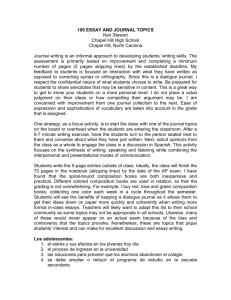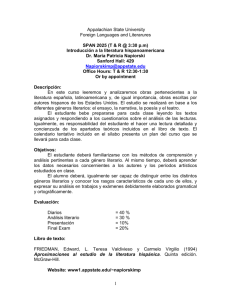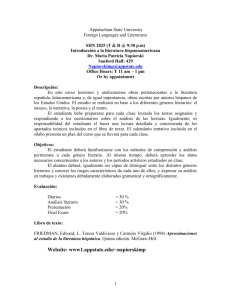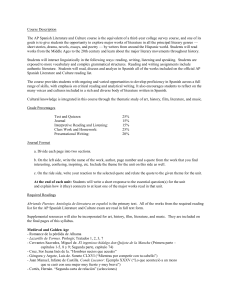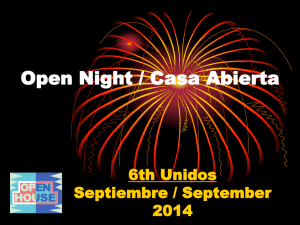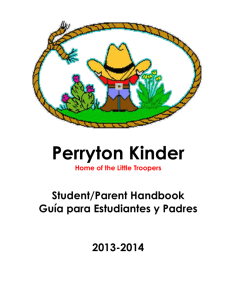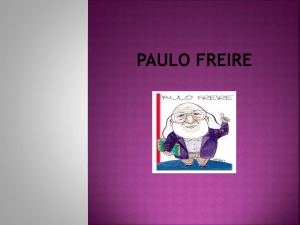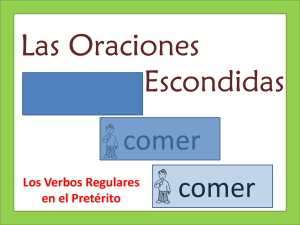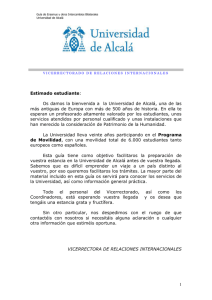Unit Objectives - Language Links 2006
advertisement
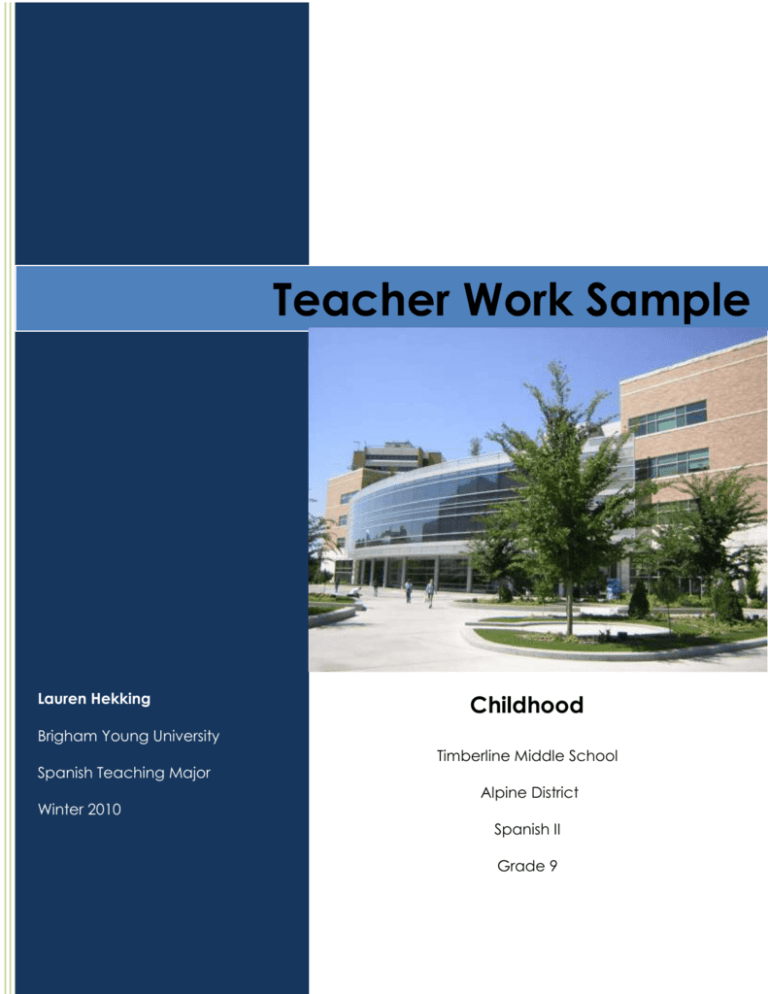
Teacher Work Sample Lauren Hekking Childhood Brigham Young University Spanish Teaching Major Winter 2010 Timberline Middle School Alpine District Spanish II Grade 9 Unit Overview ___ 1) Unit Title: Childhood ___ 2) Unit Overview: This two week long, five lesson unit is based on Susan Barksdale’s scope and sequence. It engages intermediate middle school Spanish II students in exploring the theme of family. During the unit, students will learn to describe their family and childhood using the imperfect and preterit tenses. The unit will revolve around three primary topics: family, childhood and legends. Major activities include: creating a family tree and adapting a legend. The unit culminates in a tech-based story. Additional assessments of student progress include: a show and tell experience and a traditional assessment. The unit assumes that students already know how to conjugate the preterit and imperfect tense. ___ 3) Unit Rationale: This unit is designed to help students understand the importance that the extended family plays in Mexican everyday life. It engages students in exploring how and why their childhood experiences mold them into the people they are today. This unit gives students opportunities to compare their family life and culture to that of a Hispanic family. These explorations support students in developing communicative proficiency by allowing them to communicate about their past. ___ 4) Standards-based Guiding Question: Students will explore the question: How have the experiences of your childhood shaped who you are today? ___ 6) Unit Planning Web ___ 5) National Standards: Standard 1.1, Communication (Interpersonal): Students provide and obtain information with a key pal about one’s family and childhood. Standard 1.2, Communication (Interpretive): Students understand and interpret written and spoken language on family and childhood by watching video clips and interacting with a key pal. Standard 1.3, Communication (Presentational): Students present information to an audience of listeners on the topic of family and childhood. Standard 2.1, Cultures: Students demonstrate an understanding of the relationship between the practices and perspectives of the culture studied by comparing family activities and families from Spanishspeaking countries to those of their own culture. Standard 2.1, Cultures: Students demonstrate an understanding of the relationship between the products and perspectives of the culture studied by comparing legends from Spanish-speaking countries to those of their own culture. Standard 3.1, Connections: Students reinforce and further their knowledge of art and social studies through the foreign language and its cultures by learning about the pastimes, food and toys associated with childhood in Mexico. Standard 3.2, Connections: Students acquire information and recognize the distinctive viewpoints that are only available through the foreign language and its cultures by exploring the similarities and differences between childhood here and in Mexico. Standard 4.1/4.2, Comparisons: Students demonstrate understanding of the extended family through comparisons of the cultures and traditions studied and their own by interviewing a key pal and exploring authentic texts. Standard 5.1, Communities: Students use the language within and beyond the school setting by continuing to communicate with their key pal. Standard 5.2, Communities: Students use the language for personal enjoyment and enrichment when building a relationship with their key pal. Unit Objectives ___ 6) Standards-based Unit Objectives: a) Students will construct a family tree with seven members using family names and titles in proper form (father’s last name + mother’s maiden name) of with 80% accuracy. b) Students will acquire information about childhood in Hispanic cultures from their key pal using the imperfect or preterit form on six different occasions with 75% accuracy. c) Students will identify and analyze eight sentences that include the imperfect or preterit and one that includes both tenses in a legend with 75% accuracy. d) Students will create and record a story spontaneously about a family in the past tense. They will use the preterit and imperfect tenses with 75% accuracy. Design for Instruction Due to the fact that using the preterit and imperfect in the same context is a new concept, I used a pre-test to assess the students’ ability to conjugate verbs correctly. Since I have a small percentage of students who are native speakers or who have participated in an immersion program, I also included a small section which required students to determine if preterit or imperfect are used. This information helped me to plan differentiation to account for the various levels of knowledge. The pretest was a 60 question test. We graded the tests in class and upon completion students received 20/20 points for participation in the pre-test. The test was divided into 3 subgroups: endings, conjugations, and identifying the right tense. The students averaged 86%, 71%, and 67% respectively. The overall average was 74%. These subgroups helped me pinpoint what the students might struggle with so I could incorporate mini-lessons into my curriculum. For example, many students struggled to identify the correct conjugation when given a subject pronoun. Students were successful in conjugating preterit and imperfect separately, but had little to no experience determining when to use the preterit or imperfect. Students also struggled with any irregular tense of the preterit. This let me know that I needed to re-iterate irregular stems. Lesson Plan ___ 8) Unit Lesson Plans: Lesson Plan Template Standards-based Objective(s): a) Students will provide and obtain information about family members using noun-adjective agreement in a communicative activity with 80% accuracy. b) Students will demonstrate an understanding about the formation of last names in Latino countries by making a family tree outlining three generations with 90% accuracy. Context for the Lesson Communicative Context: (The setting and the content for the communicative act) 1) Topic: importance of the family in Latino cultures 2) Communicative Function(s): identify members of their family and their relation 3) Cultural Context: una familia típica en México 4) Text Type: photos and video clips Targeted Grammatical Structure(s): subject-noun agreement Targeted Vocabulary: el primo, el tío, el nieto, el sobrino, el padrastro, la madrastra, el hermanastro (5 min.) - Warm-up: Starter This starter served as an opportunity for me to see what they remembered from Spanish I. Paso 1: Dibujan su familia Paso 2: Escriben la relación entre tú y tu familia Paso 3: Cuando terminas, lees un libro para tu carpeta (45 min.) - Contextualized Input ♦ Focus on Form ♦ Check for Understanding Paso 1: Durante el PowerPoint, escriben la traducción de las palabras Paso 2: Repitan las palabras Paso 3: Ahora vamos a practicar Pass out papers with vocabulary words skewed all over page (Hear/Circle game) Paso 4: Voy a decir la palabra en inglés Paso 5: Buscan la palabra en español y hacen un circulo Ya saben cómo jugar este juego, pregunta a un estudiante: ¿Qué son las reglas? 1. No pueden robar la crayón de su compañero 2. Mantienen la hoja en el pupitre 3. No es un deporte físico (20 min.) - Guided Practice: Modeling ♦ Instructions ♦ Scaffolding ♦ Debriefing I made “tarjetas” for each student with a name, city of origin, age and information about their family. In the class there were two separate extended families handed out. Students had to ask other students for information about themselves to determine if they were a part of the same family. Paso 1: Todos necesitan una tarjeta Paso 2: La tarjeta tiene su nombre y su información Paso 3: Necesitan encontrar los otros miembros de su familia Paso 4: Hacen preguntas para averiguar si son de su familia Dar ejemplos de buenas preguntas Hacer un modelo con dos estudiantes Paso 5: Si son de tu familia, necesitan formar un árbol genealógico When you check the answers, have students tell you the relationships (i.e. Cristina es la mamá de Enrique) to reinforce their knowledge of the vocabulary. (5 min.) - Closure: Ticket Out Paso 1: Sacan una hoja de papel. Paso 2: Escriben los nombres de las personas en su familia. Paso 3: Escriben la relación entre ustedes. Paso 4: Entregan la hoja antes de salir. (5 min.) - Independent Practice: El árbol genealógico Paso 1: Van a hacer un árbol genealógico Paso 2: Siguen la pauta de evaluación Hablar de los requisitos: los nombres, las relaciones, los dibujos (0 min.) - Assessment/Evaluation: Informal Assessment(s): observaciones: el juego, la actividad comunicativa Formal Assessment(s): la tarea: el árbol genealógico con pauta de evaluación Adaptations: Advanced students that finish starters early can work on the free read aspect of their carpetas. Students who did not earn a passing grade on their family tree have the option to attend a mini-lesson before school, make corrections and turn it in again for half credit. Back-up/Sponge Activities: Carpetas Family Communicative Activity 1. 2. Print on colored paper Cut out cards and give one to each student Nombre: Antonio Sandoval Hernández Edad: 71 Residencia: Ciudad de México Profesión: Jubilado (retired) Esposa: Sonia García de Sandoval, 72, jubilada Tienes una hija y un hijo llamado Pablo que vive en Chicago. Nombre: Sonia García de Sandoval Edad: 72 Residencia: Ciudad de México Profesión: Jubilada (retired) Esposo: Antonio Sandoval Hernández, 71, jubilado Tienes un hijo y una hija, Ruth, que vive en la Ciudad de México. Nombre: Pablo Sandoval García Edad: 41 Residencia: Chicago Profesión: Biólogo Esposa: Carmen Sandoval, 38, decoradora Tienes una hija, María, que estudia en Dallas. Nombre: Carmen Sandoval Edad: 38 Residencia: Chicago Profesión: Decoradora Esposo: Pablo Sandoval García, 41, biólogo Tienes una hija, María, que estudia en Dallas. Nombre: María Sandoval Edad: 22 Residencia: Dallas Profesión: Estudiante Padres: Pablo Sandoval García, 41, biólogo; Carmen Sandoval, 38, decoradora Nombre: Juan González Pérez Edad: 35 Residencia: Ciudad de México Profesión: Profesor de Inglés Esposa: Ruth Sandoval de González, 34, peluquera (hair dresser) Tienes tres hijos. El mayor se llama Pablo. Nombre: Ruth Sandoval de González Edad: 34 Residencia: Profesión: Esposo: Ciudad de México Peluquera (hair dresser) Juan González Pérez, 35, profesor de Inglés Tienes una hija que se llama Antonia y dos hijos. Nombre: Pablo González Sandoval Edad: 13 Residencia: Ciudad de México Profesión: Estudiante Padres: Juan González Pérez, 35, profesor de Inglés; Ruth Sandoval de González Tienes un hermano y una hermana menores. Nombre: Carlos González Sandoval Edad: 4 Residencia: Ciudad de México Profesión: No trabaja Tienes una hermana menor, Antonia, y un hermano mayor, Pablo, que es estudiante. Nombre: Antonia González Sandoval Edad: 3 Residencia: Ciudad de México Profesión: No trabaja Padres: Juan González Pérez, 35, profesor de Inglés; Ruth Sandoval de González. Tiene dos hermanos mayores. Nombre: Jaime González Vega Edad: 67 Residencia: Madrid Profesión: Jubilado (retired) Esposa: Lola Pérez Fernández, 67, jubilada Tienes una hija y dos hijos. Uno de sus hijos se llama Juan y vive en la Ciudad de México. Nombre: Lola Pérez Fernández Edad: 67 Residencia: Madrid Profesión: Jubilada (retired) Esposo: Jaime González, 67, jubilado Tienes una hija, Mariana, que vive en Toledo, y dos hijos. Nombre: José González Pérez Edad: 37 Residencia: Madrid Profesión: Dentista Padre: Jaime González Vega Tienes un hermano que vive en la Ciudad de México. También tienes una hermana. Nombre: Mariana González Pérez Edad: 33 Residencia: Toledo Profesión: Farmacéutica Esposo: Pepe Suarez Martín Tienes dos hermanos. Uno de ellos se llama José González Pérez y vive en Madrid. Nombre: Jorge Gutiérrez Marés Edad: 40 Residencia: Baja California Profesión: Doctor Esposa: Norma Sánchez de Gutiérrez, 38, maestra Tienes una hija, Belinda, que estudia en Nueva York. Nombre: Norma Sánchez de Gutiérrez Edad: 38 Residencia: Baja California Profesión: Maestra Esposo: Jorge Gutiérrez Marés Tienes una hija, Belinda, que estudia en Nueva York. Nombre: Belinda Gutiérrez Sánchez Edad: 21 Residencia: Nueva York Profesión: Estudiante Padres: Jorge Gutiérrez Sánchez, 40, doctor; Norma Sánchez de Gutiérrez, 38, maestra Nombre: Bonifacio Huerta Ortega Edad: 64 Residencia: Sonora Profesión: Jubilado (retired) Esposa: Mariola Salazar Ramírez, 62, jubilada Tienes una hija y dos hijos. Uno de sus hijos se llama Pedro y vive en Yucatán. Nombre: Mariola Salazar Ramírez Edad: 62 Residencia: Sonora Profesión: Jubilada (retired) Esposo: Bonifacio Huerta Ortega, 64, jubilado Tienes una hija, Susana, que vive en Barcelona, y dos hijos. Nombre: Susana Huerta Salazar Edad: 31 Residencia: Barcelona Profesión: Abogada Padre: Bonifacio Huerta Ortega Tienes dos hermanos. Uno de ellos se llama Roberto Huerta Salazar y vive en Sonora. Nombre: Roberto Huerta Salazar Edad: 33 Residencia: Sonora Profesión: Hombre de negocios (businessman) Padre: Bonifacio Huerta Ortega Tienes un hermano que vive en la Yucatán. También tienes una hermana. Nombre: Pedro Huerta Salazar Edad: 35 Residencia: Yucatán Profesión: Esposa: Escritor (writer) Lorena Gutiérrez de Huerta Tienes tres hijos. El mayor se llama Daniel. Nombre: Lorena Gutiérrez de Huerta Edad: 33 Residencia: Yucatán Profesión: Secretaria (secretary) Esposo: Pedro Huerta Salazar, 35, escritor (writer) Tienes una hija que se llama Cristina y dos hijos. Nombre: Cristina Huerta Gutiérrez Edad: 2 Residencia: Yucatán Profesión: No trabaja Padres: Pedro Huerta Salazar, 35, escritor; Lorena Gutiérrez de Huerta Tiene dos hermanos mayores. Nombre: Daniel Huerta Gutiérrez Edad: 14 Residencia: Yucatán Profesión: Estudiante Padres: Pedro Huerta Salazar, 35, escritor; Lorena Gutiérrez de Huerta Tienes un hermano y una hermana menores. Nombre: Francisco Huerta Gutiérrez Edad: 5 Residencia: Yucatán Profesión: No trabaja Tienes una hermana menor, Cristina, y un hermano mayor, Daniel, que es estudiante. Nombre: Cecilia Marés de Gutiérrez Edad: 70 Residencia: Yucatán Profesión: Jubilado (retired) Esposo: Mario Gutiérrez Santiago Tienes un hijo y una hija, Lorena, que vive en Yucatán. Nombre: Mario Gutiérrez Santiago Edad: 72 Residencia: Yucatán Profesión: Jubilada (retired) Esposa: Cecilia Marés de Gutiérrez Tienes una hija y un hijo llamado Jorge que vive en Baja California. KEY for Family Communicative Activity Mario Gutiérrez Santiago Cecilia Marés de Gutiérrez Lorena Gutiérrez de Huerta Jorge Gutiérrez Marés Norma Sánchez de Gutiérrez Belinda Gutiérrez Sánchez Bonifacio Huerta Ortega Mariola Salazar Ramírez Pedro Huerta Salazar Susana Huerta Salazar Lorena Gutiérrez de Huerta Daniel Huerta Gutiérrez Francisco Huerta Gutiérrez Cristina Huerta Gutiérrez Roberto Huerta Salazar Lesson Plan Template Standards-based Objective(s): Students will understand and interpret written language about past experiences by differentiating between the preterit and imperfect form in a short passage with 75% accuracy a) Students will understand and interpret written language about past experiences by differentiating between the preterit and imperfect form in a short passage with 75% accuracy. Context for the Lesson Communicative Context: (The setting and the content for the communicative act) 1) Topic: a family in México 2) Communicative Function(s): talking about the past 3) Cultural Context: family in México 4) Text Type: short passage about a family in México Targeted Grammatical Structure(s): preterit and imperfect Targeted Vocabulary: el semáforo, conducir (5 min.) - Warm-up: Starter Paso 1: Ven el video Paso 2: Contestan las preguntas ¿Quién es? ¿De dónde es? ¿Cómo es su familia? Paso 3: Escriben tres preguntas de la niñez de Jared. The video is of Jared, who will be their key pal. This is an introduction and we will be skyping him at a later time. (20 min.) - Contextualized Input ♦ Focus on Form ♦ Check for Understanding Usar un semáforo para explicar el pretérito y el imperfecto Paso 1: Colorean el semáforo ¿Qué hacemos cuando estamos conduciendo y hay una luz verde? Paso 2: Toman notas en la luz verde ¿Qué hacemos cuando estamos conduciendo y hay una luz roja? Paso 3: Toman notas en la luz roja After learning the triggers for preterit and imperfect tense, ask students to explain the principle to their partner in their own words. Have students give 1 or 2 examples. Use cold-calling (you pick who answers the questions) for increasingly difficult questions. (25 min.) - Guided Practice: Modeling ♦ Instructions ♦ Scaffolding ♦ Debriefing Dar tarjetas rojas y verdes a cada estudiante Paso 1: Yo voy a leer un cuento en el pasado Paso 2: Hay muchos verbos Paso 3: Deciden si es pretérito o imperfecto Paso 4: Si es pretérito, levanta la roja Paso 5: Si es imperfecto, levanta la verde (20 min.) - Guided Practice: Modeling ♦ Instructions ♦ Scaffolding ♦ Debriefing Give a sentence strip to each group (the class is divided into three groups). Paso 1: La primera persona lee la pregunta. Paso 2: ¡No puede mostrar ni pasar la pregunta! Paso 3: Susurra a la próxima estudiante la pregunta. Paso 4: La última persona contesta la pregunta en la pizarra. Repasar la significancia como clase. These sentence strips include questions about family/childhood. Students can tell me why it is preterit or imperfect for extra team points. The questions will also serve as a springboard for the questions students write to their key pal. (5 min.) - Closure: Ticket out of class Paso 1: Escriben dos preguntas acerca de la niñez. Paso 2: Usan el imperfecto en una oración. Paso 3: Usan el pretérito en la otra. Paso 4: Entregan la hoja antes de salir. (5 min.) - Independent Practice: Passage about a family Paso 1: Leen el cuento Paso 2: Necesitan escoger ¿pretérito o imperfecto? Paso 3: Colorean los verbos pretéritos con rojo Paso 4: Colorean los verbos imperfectos con verde (0 min.) - Assessment/Evaluation: (Provide feedback, info. re: progress toward lesson objective, next steps) Informal Assessment(s): starter, comprehension check: las tarjetas, el juego Formal Assessment(s): homework Adaptations: Provide students with guided notes. Back-up/Sponge Activities: Carpetas Pretérito y Imperfecto When I was ( I / P ) little, my family used ( I / P ) to go camping every summer. Every year we camped ( I / P ) near a beautiful lake and a leafy forest. Last summer, my husband and I decided ( I / P ) to continue the tradition. We camped ( I / P ) in Provo Canyon. There was ( I / P ) a stream near our tent and the mountains were ( I / P ) very beautiful. I was ( I / P ) very scared of bears. The day before I left I heard ( I / P ) many stories about bears eating people on the news. I did not want ( I / P ) a bear to eat me. I did not sleep ( I / P ) the whole night because I was ( I / P ) so scared. The following morning, we got up ( I / P ) early to go on a hike. On the hike we found ( I / P ) a beaver’s dam and a waterfall. We returned ( I / P ) to our campsite and saw ( I / P ) bear tracks all around our tent. I told ( I / P ) my husband that we were ( I / P ) leaving. I was ( I / P ) packing up all of our things when all of a sudden I heard ( I / P ) a growl. I looked ( I / P ) up and saw ( I / P ) the bear in the tree above me. We dropped ( I / P ) everything, ran ( I / P ) to the car, and drove ( I / P ) away. Now read the story in Spanish and fill in the blanks with the preterit or imperfect forms of the verbs in parentheses. Cuando yo________________ (ser) niña, mi familia y yo________________ (ir) a acampar cada verano. Todos los años nosotros________________ (acampar) cerca de un lago bello y un bosque verde. El verano pasado, mi esposo y yo________________ (decidir) seguir la tradición. Nosotros ______________ (acampar) en el cañón de Provo. ________________ (ser) un arroyo cerca de nuestro campamento y las montañas________________ (ser) muy bellas. Yo________________ (tener) miedo de los osos. El día anterior, yo ________________ (oír) muchos cuentos de los osos peligrosos en las noticias. No________________ (querer) que un oso me comiera. No________________ (dormir) nada porque yo________________ (tener) mucho miedo. La siguiente mañana, nosotros nos________________ (levantar) temprano para una caminata. Durante la caminata nosotros________________ (ver) una madriguera y una cascada. Nosotros________________ (regresar) al campamento y nosotros ________________ (ver) unas huellas de un oso. Yo________________ (decir) a mi esposo que ya ________________ (salir). Yo________________ (estar) empacando cuando yo________________ (oír) un gruñido. Yo________________ (ver) un oso en el árbol. Nosotros________________ (dejar) todo, ________________ (correr) al coche, y nos ________________ (salir). Lesson Plan Template Standards-based Objective(s): b) Students will understand and interpret written language about past experiences by differentiating between the preterit and imperfect form by creating a storyboard about the short film Jack Jack Ataca with 80% accuracy Context for the Lesson Communicative Context: (The setting and the content for the communicative act) 1) Topic: childhood 2) Communicative Function: talking about the past 3) Cultural Context: 4) Text Type: Pixar Short Jack Jack Ataca Targeted Grammatical Structure(s): preterit and imperfect Targeted Vocabulary: el timbre, la pared, perseguir, encender, apagar, desaparecerse, la tarjeta (5 min.) - Warm-up: Starter Post a copy of La Tamalada from Carmen Lomas Garza’s En Mi Familia Paso 1: ¿Qué ves? Paso 2: Escriben lo que pasó durante esta tradición familiar. Paso 3: Escriben de su propia tradición familiar. (30 min.) - Contextualized Input ♦ Focus on Form ♦ Check for Understanding Paso 1: Primero, solo vamos a escuchar Debrief on movie content Paso 2: Esta vez, escriben lo que pasó Paso 3: Escriben una oración en el pretérito y una en el imperfecto Paso 4: Ahora, dibujan lo que pasó Repeat for each scene (25 min.) - Guided Practice: Modeling ♦ Instructions ♦ Scaffolding ♦ Debriefing Paso 1: Van a crear tu propio cuento Paso 2: Necesitan una descripción (imperfecto) para cada cuadro Paso 3: Necesitan una acción (pretérito) para cada cuadro Do an example of one box on the board (15 min.) - Closure: compartir los cuentos Paso 1: Grupo 1 y 2 hagan una fila. Paso 2: Grupo 3 y 4 hagan una fila. Paso 3: Van a compartir sus cuentos Paso 4: Tienen dos minutos para compartir los dos. Paso 5: Cuando oyes el timbre, cambian. Repeat 3x (5 min.) - Independent Practice: Jack Jack Ataca Cloze Passage Paso 1: Si el verbo es pretérito, colorean el verbo verde Paso 2: Si el verbo es imperfecto, colorean el verbo rojo Paso 3: Ahora, conjugar los verbos (0 min.) - Assessment/Evaluation: Informal Assessment(s): Starter, Comprehension Check: Jack Jack Ataca Formal Assessment(s): Storyboard, Homework Adaptations: Students with learning disabilities received a grade based on individual progress. Back-up/Sponge Activities: Carpetas Guión gráfico: Jack Jack Ataca Nombre: _________________________ Guión gráfico: Tu propio cuento Nombre: _________________________ Lesson Plan Template Standards-based Objective(s): c) Students will create legends using the imperfect and preterit. d) Students will reinforce knowledge about juvenile literature and the motifs of legends. Context for the Lesson Communicative Context: 1) Topic: legends from México 2) Communicative Function: Tell a story in the past 3) Cultural Context: traditional legends 4) Text Type: El Cucú, El día que nevaron tortillas y La llorona Targeted Grammatical Structure(s): preterit and imperfect Targeted Vocabulary: (5 min.) - Warm-up: Paso 1: Piensan en una leyenda de su cultura Paso 2: Escriban tres oraciones que describen lo que pasó Paso 3: Usan el pretérito o el imperfecto (15 min.) - Contextualized Input ♦ Focus on Form ♦ Check for Understanding Paso 1: Leemos el cuento Paso 2: Cuando leo, llenan su librito Review what they need to fill out in the book:: characters, descriptions, etc. (35 min.) - Guided Practice: Modeling ♦ Instructions ♦ Scaffolding ♦ Debriefing Dar cada estudiante una leyenda. El compañerismo va a recibir dos cuentos diferentes. Paso 1: Como individual, leen la leyenda Paso 2: Escriben un resumen de lo que pasó Paso 3: Comparten el resumen con sus compañeros Paso 4: Llenan el librito con la información de su compañero (20 min.) - Guided Practice: Modeling ♦ Instructions ♦ Scaffolding ♦ Debriefing I sent Jared their questions and he answered them in a video. Each student has a list of questions that Jared answers in the video. Paso 1: La primera vez solamente vamos a escuchar. Repasar las preguntas como clase. Preparar para ver el video otra vez. Paso 2: Esta vez contestan las preguntas Paso 3: ¿Qué nos preguntó Jared? Repasar las preguntas de Jared y que significa Paso 4: Como individuos, contestan las preguntas. (5 min.) - Independent Practice: Paso 1: Para crédito extra, ven a La Hora de Cuentos For extra credit students had the opportunity to participate in a Story Hour for Spanish speakers in South Provo. (0 min.) - Assessment/Evaluation: Informal Assessment(s):observations: sharing stories Formal Assessment(s):librito Adaptations: Students with learning disabilities were permitted to give summaries in English. Back-up/Sponge Activities: Carpetas El día que nevaron tortillas Había una vez un hombre muy pobre. Él se llamaba Juan y era trabajador. Él nunca iba a la escuela y no podía leer ni escribir. Juan no era muy inteligente. Siempre tenía problemas. Pero tenía la buena suerte de tener una esposa muy inteligente. Ella siempre ayudaba a su esposo a resolver sus problemas. Un día el esposo encontró oro al lado de la calle. Llevó todo a la casa para mostrarle a su esposa. La esposa estaba muy sorprendida. Ella dijo, “No dices a nadie que tenemos el oro. El oro es de los ladrones.” La esposa pensó, “mi esposo no puede guardar un secreto.” Durante la siesta del esposo, la esposa tuvo una idea. Ella hizo muchas tortillas. Hizo más y más tortillas. Convirtió cien libras de harina en tortillas. Después, ella llevó las tortillas afuera y las tiró en la tierra. Cuando el esposo se despertó, miró afuera y vio que la tierra estaba cubierta de tortillas. Juan preguntó a su esposa, “¿Qué es esto?” La mujer salió también, “¡Ay, caramba!” Ella dijo, “Parece que nevaron tortillas anoche.” El hombre dijo, “¿Nevaron tortillas? ¿De qué hablas?” “¿Cómo? ¿No sabes que pueden nevar tortillas? Eres muy ignorante. Necesitas ir a la escuela.” El hombre fue a la escuela. El hombre no podía leer ni escribir y fue al primer grado. Él tenía que sentarse en una silla muy pequeña. Él no sabía las respuestas y no le gustó la escuela. Él salió de la escuela y corrió a casa. Cuando él llegó a la casa, vio a los ladrones que buscaban oro. “¿Dónde está el oro?” preguntaron los ladrones. El esposo dijo, “¿Oro?, mi mujer escondió el oro.” La esposa dijo que no sabía nada del oro. “¿No recuerdas?” dijo el esposo, “fue el día que nevaron tortillas. Y tú me hiciste ir a la escuela.” Los ladrones se miraron unos a otros, “¿Dice que nevaron tortillas? ¿Y su mujer lo hace ir a la escuela? ¡El hombre está loco!” Los ladrones se fueron. El esposo y la esposa eran ricos y vivieron felices. La Llorona Había una vez una chica muy bonita. Ella se llamaba María. Ella era la chica más bonita en la ciudad. Quizás la chica más bonita en el mundo. Ella era egoísta. Ella quería ropa muy cara. Ella quería un esposo muy rico y guapo. No le interesaba si era un buen hombre. Un día un hombre llegó a la ciudad. El se llamaba Gregorio y era muy guapo. Él cantaba y tocaba la guitarra. Todas las chicas se enamoraban de él. María decidió casarse con él. Ella se casó con Gregorio y todo era bien. Tuvieron dos hijos. Después de dos años, Gregorio no era muy amable. Él se fue por meses y solo regresó para jugar con los niños. Toda la ciudad dijo que Gregorio iba a dejar María para una mujer rica. Un día Gregorio y una mujer elegante vinieron para visitar los niños. Gregorio ni la vio a ella. María estaba muy enojada y celosa. Ella tomó los niños y los tiró en el río. Ellos se desaparecieron con el corriente. Ella estaba muy enojada y no prestaba atención a donde iba. Ella se cayó en el río. El próximo día alguien encontró una mujer bonita y muerta cerca del río. Sus padres tuvieron un funeral para ella. Ella no descansaba en paz. Cada noche su fantasma se levantaba y pasaba por el bosque. Ella decía: – Aaaaaaayyyyy…mis hijos… ¿Dónde están mis hijos? Cada noche ellos vieron a la fantasma de María y oyeron a la fantasma de María. Todos se llamaban La Llorona. Y decían a los niños: –Por la noche, quédense en casa porque La Llorona busca sus hijos. Ella es muy loca y va a pensar que ustedes son sus hijos. Nunca les volveremos a ver. Los niños siempre escuchaban. Durante el día los niños jugaban cerca del río, pero por la noche corrían a casa. Lesson Plan Template Standards-based Objective(s): e) Students will create a story about the past using the imperfect and preterit tense in a two minute slideshow with 75% accuracy. Context for the Lesson Communicative Context: (The setting and the content for the communicative act) 1) Topic: childhood 2) Communicative Function: telling a story that occurred in the past 3) Cultural Context: family in Mexico (model slideshow will be with culturally authentic photos) 4) Text Type: photos Targeted Grammatical Structure: preterit and imperfect Targeted Vocabulary: los edificios, el policía, el fuente, el parque (10 min.) - Warm-up: Starter Post Murillo’s Dos niños comiendo uvas y melón on the board Paso 1: Miran la foto. Paso 2: ¿Cómo consiguieron las uvas y el melón? Paso 3: Usan el pretérito y el imperfecto. Paso 4: Escriben cuatro oraciones. (20 min.) - Guided Practice: Modeling ♦ Instructions ♦ Scaffolding ♦ Debriefing Before going to the lab we read through the rubric, watched an example, and reviewed lab procedures Paso 1: Abren el programa Paso 2: Tienen 30 segundos para pensar en ideas Paso 3: Tienen 30 segundos para hablar Paso 4: Hagan clic en el botón <<record>> Paso 5: Ahorran su grabación (20 min.) - Guided Practice: Modeling ♦ Instructions ♦ Scaffolding ♦ Debriefing Go to lab, record using PhotoStory3 Paso 1: Después de grabar todo, vamos a escuchar Paso 2: Escriben lo que dijiste en su hoja (20 min.) - Guided Practice: Modeling ♦ Instructions ♦ Scaffolding ♦ Debriefing Students will be graded on their corrected transcript of their story. Fluency and pronunciation are other factors, but making corrections will increase their score. Paso 1: Ahora corrigen en otro color Paso 2: Ten cuidado con los verbos Paso 3: Cuando terminan, cambian con un compañero Paso 4: Ellos van a corregir también (10 min.) - Closure: Watch 1-2 slideshows Ask for volunteers, watch their slideshow Paso 1: ¿Qué pasó en este cuento? Discuss what occurred in the story (0 min.) - Independent Practice: Study for traditional test Paso 1: ¿Qué necesitan saber para el examen? Review content brought up, have students answer questions on the board Review any content students have not included (0 min.) - Assessment/Evaluation: Formal Assessment(s):Speaking Assessment Adaptations: Students with learning disabilities received a grade based on individual progress. Back-up/Sponge Activities: Carpetas Report of Student Learning Whole class Whole Class Comparison of Learning Objectives To achieve the objectives, students needed to complete the assignments with 75% accuracy. Overarching learning goal: Be able to create/tell a story using preterit and imperfect tense with 75% accuracy. Students who met this objective: 29 Student that did not met this objective: 0 Objective 1: be able to compare Mexican family culture to that of their own. Students who met this objective: 26 Student that did not met this objective: 3 Objective 2: be able to recognize and identify the differences between preterit and imperfect tenses. Students who met this objective: 24 Student that did not met this objective: 5 Objective 3: be able to understand and interpret a text about past experiences. Be able to produce text about past experiences. Students who met this objective: 29 Student that did not met this objective: 0 Objective 4: able to spontaneously tell a story that occurred in the past Students who met this objective: 29 Student that did not met this objective: 0 Pre/post-test Comparison Students who did not receive full credit on their family tree neglected to include compound last names. Students reviewed last names in-depth in class and received a rubric which high-lighted the need for compound last name, as well as a model. Students were given the option to correct and return for half credit. No action was taken. Two of the five students who did not earn 75% on the legend assignment turned it in late, resulting in a 50% of the grade earned. Class time was given to complete the majority of the assignment. A five sentence summary was given as homework and the other three students who did not reach the objective did not complete the assignment. Implications for Future Teaching My unit started out strong. I felt like my lesson plans were building on the knowledge they had learned the class period before and students could see themselves progressing. In week two, the thematic unit was not as tightly encapsulated as I had planned. I had spent a lot of time ahead of time perfecting my first few lesson plans instead of practicing backward design. In week two I found that I would not be able to fit in the projects and activities planned and had to cut some things out. Also, in week two I did not include as much culture as I would have liked. In the future I would like all my lesson plans founded in culture. Furthermore, I love the opportunities Web 2.0 holds for students to analyze and create. I had several tech-based lessons planned, but even on the first day of the semester, all five labs were completely booked by the English classes. I believe these changes would have a positive effect on my students’ ability to learn and progress. First of all, backward design ensures that my assessments are consistent with what I teach, and sharpens the focus of my entire unit. It would also aid me in more efficient planning. For example, I had a culminating activity that I planned to use to finish off the unit, but I ran out of time and could not include this in my unit. I would like to include more culture because of the power culture holds. Grammar and vocabulary can teach someone to speak a language, but culture changes perspectives, breaks down barriers and opens doorways. That is a very powerful gift to give your students. I also think technology holds an important place in the foreign language classroom. Technology engages students and allows them to use their knowledge at a higher level: they can create, evaluate and defend. References Alpine, Utah. (2010). < http://en.wikipedia.org/wiki/Alpine,_Utah> Carmen Lomas Garza. (1996). In My Family/En mi familia. San Francisco, CA: Children’s Book Press. Cherry, Peter. (2003). Murillo: Scenes of Childhood. London, England: Merrell Publishers. Gould, R. (Producer), & Bird, B. (Director). (2005). Jack Jack Ataca [Motion Picture]. United States: Pixar. Hayes, Joe. (2003). The Day it Snowed Tortillas/El día que nevaron tortillas. El Paso, TX: Cinco Puntos Press.
